- Home
- »
- Homecare & Decor
- »
-
Cosmetics Market Size, Share And Growth Report, 2030GVR Report cover
![Cosmetics Market Size, Share & Trends Report]()
Cosmetics Market Size, Share & Trends Analysis Report By Product (Skin Care, Hair Care), By End-user (Men, Women), By Distribution Channel (Offline, Online), By Region (North America, Europe), And Segment Forecasts, 2024 - 2030
- Report ID: GVR-4-68039-924-6
- Number of Pages: 110
- Format: Electronic (PDF)
- Historical Range: 2018 - 2023
- Industry: Consumer Goods
Cosmetics Market Size & Trends
The global cosmetics market size was estimated at USD 295.95 billion in 2023 and is expected to grow at a CAGR of 6.1% from 2024 to 2030. One of the primary factors driving market expansion is the increasing awareness among consumers to enhance their personal appearance. Among millennials, products related to skincare, color cosmetics, and hair care have gained popularity as essential components of their daily grooming routines. Additionally, the introduction of cosmetics featuring natural, non-toxic, and organic ingredients has further contributed to the market's expansion.
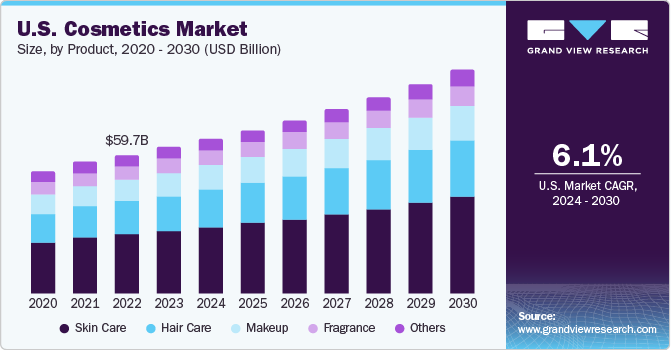
Personal care products (PCPs) are commonly utilized for purposes of personal hygiene, grooming, cleaning, and enhancing one's appearance. This category encompasses a wide range of items, including hair & skincare products, UV protection creams, facial cleansers, insect repellents, fragrances, perfumes, soaps, detergents, shampoos, conditioners, and toothpaste.
As per a 2021 article from the National Center for Biotechnology Information, PCPs belong to the class of self-care items primarily employed for personal hygiene, cleanliness, and grooming. Globally, approximately 30-40% of dermatological prescriptions include a PCP and an average person utilizes at least two PCPs within a span of 24 hours.
Soap plays a vital role in skin care, serving as an essential tool to maintain cleanliness and overall health. According to Consumer Reports, an organization involved in product and service testing, when considering bath products, consumers often have distinct preferences. Consumer trends and preferences regarding skincare and haircare products are strongly influenced by environmental awareness and sustainability concerns.
According to the environmental awareness website TheRoundup.org, in 2023, 78% of consumers prioritize sustainability, with nearly 55% of consumers showing a willingness to pay more for eco-friendly brands. Shoppers seek accredited brands that adhere to environmental and ethical standards, emphasizing the use of sustainable and body-friendly materials. Brands that incorporate organic, natural ingredients and promote their wellness benefits are more likely to gain traction among eco-conscious consumers.
Market Concentration & Characteristics
Market growth stage is high and pace of the industry growth is accelerating. The market is dominated by established companies that have a significant market share and strong manufacturing capabilities. These companies have extensive distribution networks and established relationships with customers.
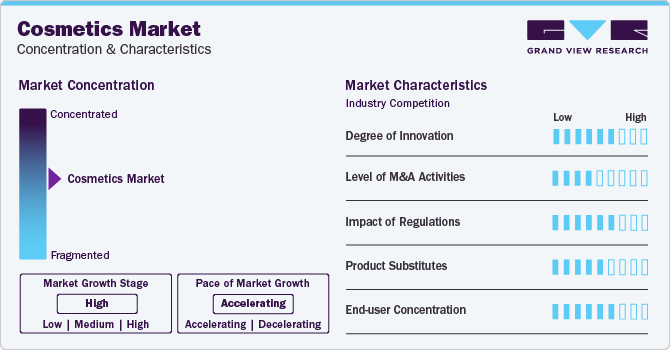
Innovation, product launches, brand introductions, and collection expansions aid in refreshing consumer interest, meeting evolving trends, and sustaining brand relevance. These strategies allow companies to cater to diverse consumer needs, maintain competitiveness, and capitalize on market shifts, ensuring long-term success and customer loyalty. For instance, in September 2023, The Estée Lauder Companies Inc. under its Clinique brand expanded the Moisture Surge collection to include the innovative SPF25 Sheer Hydrator line.
Regulations are designed to safeguard consumer health and ensure the safety and efficacy of cosmetic products. Compliance with these regulations often involves significant investment in research, testing, and administrative processes by cosmetic companies. Non-compliance can lead to legal penalties, product recalls, damage to brand reputation, and loss of consumer trust.
The high prevalence of counterfeit products, coupled with their easy availability and cheaper price, poses a significant threat to branded and original cosmetic products. There are various substitutes available, including natural or homemade remedies, alternative beauty routines, or even non-beauty-related products.
Product Insights
The skin care cosmetics accounted for a revenue share of 43.3% in 2023. The growing importance and awareness regarding skin care has led to changing consumer interest toward skincare products. The growing interest in maintaining an ideal skincare routine has prompted manufacturers to focus on developing a wide range of trending products. Numerous cosmetics companies are also venturing into the skincare market with the launch of new products.
The demand for hair care cosmetics is projected to grow at a CAGR of 7.0% over the forecast period. Hair care is one of the key categories in the cosmetic products market, witnessing growing demand among consumers. Renowned brands such as Sunday Riley, The Inkey List, and Drunk Elephant have blurred the boundary between skincare and haircare. These brands leverage their expertise in product development, ingredient formulation, and skin concerns to create specialized hair products.
End-user Insights
Women cosmetics accounted for a revenue share of 62.9% in 2023. The demand for cosmetics among women across the globe is experiencing a transformative shift influenced by influencers and celebrities. International celebrities such as Rihanna, Selena Gomez, and Lady Gaga have successfully launched their beauty brands like Fenty Beauty, Rare Beauty, and Haus Labs, respectively. This reflects a growing trend where celebrities leverage their influence to create cosmetic product lines, shaping consumer preferences and driving the growth of the market.
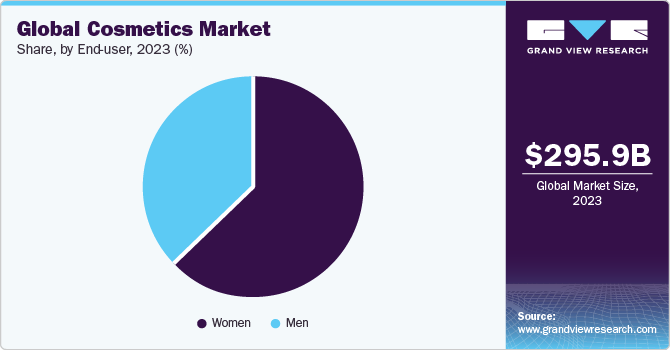
The demand for men’s cosmetics is projected to grow at a significant CAGR over the forecast period. According to an October 2022 study published in the Global Cosmetic Industry, approximately 27% of men surveyed expressed dissatisfaction with their current skin care products, stating that these products do not effectively address their specific facial skin care concerns. In addition, 52% of men reported purchasing more color cosmetics than they did five years ago.
Distribution Channel Insights
The sales of cosmetics through offline channel accounted for a revenue share of 72.2% in 2023. Consumers often prefer to buy cosmetic products through offline channels because they can physically see, touch, and test products, especially when it comes to cosmetics, skincare, and fragrances, allowing them to assess texture, scent, and suitability for their skin or preferences.
The online sales of cosmetics is projected to grow at a significant CAGR over the forecast period. According to an August 2023 article by Ellie Conley, Sephora recently introduced dedicated sections on its website for new product launches to cater to customers seeking beauty, skin, hair, and makeup products. Its products are released in seven categories on its website: Makeup, Just Dropped, Skin Care, Bath and Body, Fragrance, Hair, and Tools and Brushes.
Regional Insights
The cosmetics market in North America held 23.8% of the global revenue in 2023. The increasing number of consumers who are conscious about their appearance and the growing adoption of cosmetic products among middle- and high-income individuals support the sales of cosmetic products in the region. The presence of established manufacturers such as Procter & Gamble and Unilever, along with the growing number of retailers, is expected to further support market growth.
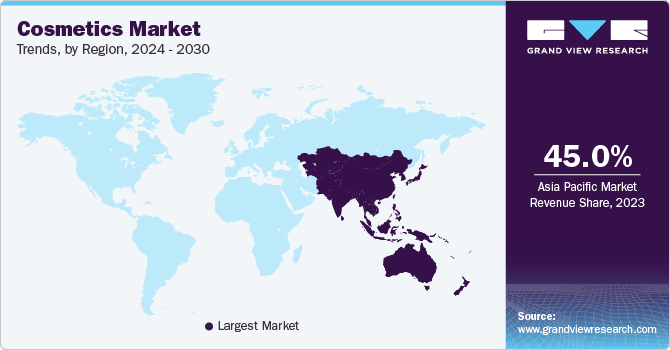
U.S. Cosmetics Market Trends
The market in the U.S. is expected to grow at a CGAR of 6.1% from 2024 to 2030. The demand for cosmetics in the U.S. is driven by a combination of factors, including a desire for self-enhancement, societal beauty standards, and the influence of media and social platforms. In addition, the cosmetics industry offers diverse product choices, fostering personal expression and creativity, further fueling its popularity.
Europe Cosmetics Market Trends
Advancements in technology, such as augmented reality (AR) for virtual makeup try-ons and skincare analysis apps, have enhanced the consumer shopping experience and driven demand for innovative cosmetic products in the region. For instance, In July 2022, Proven Skincare, a U.S.-based manufacturer, revealed its global expansion into the European Union and the U.K. The company employs artificial intelligence (AI) and big data to create its five-product lineup, leveraging its exclusive Skin Genome Project, a beauty database, to tailor personalized skincare solutions.
Asia Pacific Cosmetics Market Trends
Asia Pacific held the largest market share of 45% in 2023. With growing global environmental consciousness, many consumers in Asia seek sustainable and eco-friendly alternatives. As a result, cosmetic brands across the region are incorporating a wide range of natural ingredients in beauty care products, like green tea, ginseng, rice, aloe vera, and various botanical extracts, to cater to the demand for more sustainable and holistic beauty options.
Key Cosmetics Company Insights
The market features both established global firms and emerging players. Key industry leaders prioritize product innovation, differentiation, and distinctive designs in line with evolving consumer preferences. Leveraging extensive global distribution networks, these major players effectively reach diverse customer bases and tap into emerging markets.
Key Cosmetics Companies:
The following are the leading companies in the cosmetics market. These companies collectively hold the largest market share and dictate industry trends.
- Coty Inc.
- L’Oréal Group
- Estee Lauder Companies, Inc.
- Revlon Consumer Products LLC
- Avon Products, Inc.
- Unilever
- Company 7
- Godrej Group
- Procter & Gamble
- Beiersdorf AG
- Henkel AG & Co KGaA
- Kao Corporation
- Hoyu Co., Ltd.
Recent Developments
-
In January 2024, L'Oreal Group’s venture capital arm, BOLD (Business Opportunities for L'Oreal Development), disclosed an investment in Timeline, a consumer health company. Specializing in aging and longevity, Timeline incorporates Mitopure, its proprietary technology, into a range of topical skincare products and supplements. The recent funding was done with the intent to support the company's expansion efforts in the beauty, food, and health sectors.
-
In December 2023, Estée Lauder entered into a collaboration with the Stanford Center and made an initial commitment of three years to support the center's newly established Program on Aesthetics & Culture. This commitment aimed to finance various research endeavors, including 'New Map of Life' post-doctoral fellowships and other initiatives aimed at understanding perceptions on longevity and vitality.
Cosmetics Market Report Scope
Report Attribute
Details
Market size value in 2024
USD 312.33 billion
Revenue forecast in 2030
USD 445.98 billion
Growth rate
CAGR of 6.1% from 2024 to 2030
Actuals data
2018 - 2023
Forecast period
2024 - 2030
Quantitative units
Revenue in USD Billion and CAGR from 2024 to 2030
Report coverage
Revenue forecast, company ranking, competitive landscape, growth factors, and trends
Segments covered
Product, end-user, distribution channel, region
Regional scope
North America; Europe; Asia Pacific; Central & South America; Middle East & Africa
Country scope
U.S.; Canada; Mexico; U.K.; Germany; France; Italy; Spain; China; India; Japan; Australia & New Zealand; South Korea; Brazil; South Africa
Key companies profiled
Coty Inc.; L’Oréal Group; Estee Lauder Companies, Inc.; Revlon Consumer Products LLC; Avon Products, Inc.; Unilever; Company 7; Godrej Group; Procter & Gamble; Beiersdorf AG; Henkel AG & Co KGaA; Kao Corporation; Hoyu Co., Ltd.
Customization scope
Free report customization (equivalent up to 8 analysts working days) with purchase. Addition or alteration to country, regional & segment scope.
Pricing and purchase options
Avail customized purchase options to meet your exact research needs. Explore purchase options
Global Cosmetics Market Report Segmentation
This report forecasts revenue growth at global, regional & country levels and provides an analysis on the latest trends and opportunities in each of the sub-segments from 2018 to 2030. For this study, Grand View Research has segmented the global cosmetics market report based on product, end-user, distribution channel, and region.
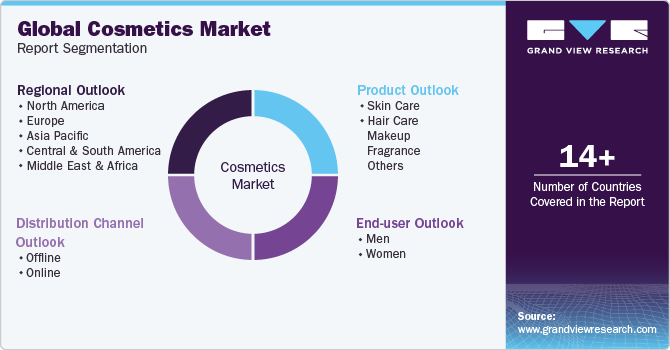
-
Product Outlook (Revenue, USD Billion, 2018 - 2030)
-
Skin Care
-
Hair Care
-
Makeup
-
Fragrance
-
Others
-
-
End-user Channel Outlook (Revenue, USD Billion, 2018 - 2030)
-
Men
-
Women
-
-
Distribution Channel Outlook (Revenue, USD Billion, 2018 - 2030)
-
Offline
-
Online
-
-
Regional Outlook (Revenue, USD Billion, 2018 - 2030)
-
North America
-
U.S.
-
Canada
-
Mexico
-
-
Europe
-
U.K.
-
Germany
-
France
-
Italy
-
Spain
-
-
Asia Pacific
-
China
-
India
-
Japan
-
Australia & New Zealand
-
South Korea
-
-
Central & South America
-
Brazil
-
-
Middle East & Africa (MEA)
-
South Africa
-
-
Frequently Asked Questions About This Report
b. The global cosmetics market was estimated at USD 295.95 billion in 2023 and is expected to reach USD 312.33 billion in 2024.
b. The global cosmetics market is expected to grow at a compound annual growth rate of 6.1% from 2024 to 2030 to reach USD 445.98 billion by 2030.
b. Asia Pacific dominated the cosmetics market with a share of around 45.0% in 2023. Regional players in the cosmetics market are expanding their reach by distributing products through local retailers while employing diverse marketing strategies
b. Some of the key players operating in the cosmetics market include Coty Inc.; L’Oréal Groupe; Estee Lauder Companies, Inc.; Revlon Consumer Products LLC; Avon Products, Inc.; Unilever; Company 7; Godrej Group; Procter & Gamble; Beiersdorf AG; Henkel AG & Co KGaA; Kao Corporation; Hoyu Co., Ltd.
b. Key factors that are driving the cosmetics market growth include growing focus on personal hygiene and grooming, complexity of skincare routines & strategic initiatives by major players, and increasing popularity of men's grooming products.
Share this report with your colleague or friend.
![gvr icn]()
NEED A CUSTOM REPORT?
We can customize every report - free of charge - including purchasing stand-alone sections or country-level reports, as well as offer affordable discounts for start-ups & universities. Contact us now
![Certified Icon]()
We are GDPR and CCPA compliant! Your transaction & personal information is safe and secure. For more details, please read our privacy policy.
We are committed towards customer satisfaction, and quality service.
"The quality of research they have done for us has been excellent."





